Photo Corners headlinesarchivemikepasini.com
![]()
A S C R A P B O O K O F S O L U T I O N S F O R T H E P H O T O G R A P H E R
![]()
Reviews of photography products that enhance the enjoyment of taking pictures. Published frequently but irregularly.
Leveling Up With Creative Cloud


11 December 2012
As Photoshop Product Manager Zorana Gee told us at a briefing in November, this is the first time Photoshop has been updated with new features within six months of a major release.
There have been plenty of smaller stealth improvements since Creative Suite 6 was released. But every once in a while, apparently, you have to draw some attention to yourself or nobody will applaud.
Although there should be 200,000 subscribers, 80 percent of whom have chosen an annual plan, pretty happy about the new powers they are acquiring today. That's the number of paid members Adobe has already collected.
FIVE NEW ADDITIONS
Today's announcement, in a nutshell, highlighted five "exclusive additions" to Creative Cloud:
- New Photoshop features
- New Muse features focused on designing mobile Web sites
- Desktop Sync
- Creative Cloud training
- Creat Cloud for teams
If your eyes glazed over, slap yourself and take another look. Those are actually pretty enticing additions. Not your average press release stuff.
PHOTOSHOP
The Photoshop 13.1 features move even this venerable tool forward a few squares. When Zorana demonstrated them, we could hardly believe at least some of them hadn't been in there all along.
She started with a reminder that Windows XP support has been dropped and that 3D features will now require a graphics card with 512-MB, which had been an unenforced recommendation.
Of course, we realized that HiDPI/Retina display support couldn't have been in there before because that's pretty recent technology. But it's the one feature that will be available to all Photoshop and Illustrator customers at the same time. The rest of this is Creative Cloud only.
So what is a HiDPI/Retina display? Just more pixels on screen. So when you zoom in at 100 percent, you see more of your image than you see when zooming at 100 percent on a lower-resolution display. You also see smaller things (like fonts) with better definition.
The Crop tool, updated for CS6, has gotten a Resolution option to make it easier to specify. By popular demand.

Crop Resolution. A little clearer.
That's the kind of change, Zorana said, that used to take between 18 to 24 months before it made it into a release. But Photoshoppers needed it and it got done within six months.
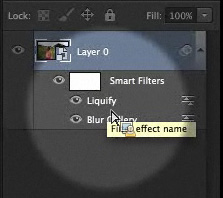
Smart Object Effects. Liquify and Blur Gallery become non-destructive.
Smart Object support for Blur Gallery effects and Liquify might seem obscure, but if you applied any of these new effects to an image in CS6, you left the land of non-destructive editing and made a permanent change to your image. Now they can be added non-destructively, as a Smart Object. And you can do that to a video clip, too. "This is really, truly amazing," Zorana said.
Actions, oddly enough, has gotten some attention to. Not a lot but a little goes a long way when that little is the introduction of conditional statements. If-then-else.
A Conditional Action looks for a certain condition like your document is landscape or square or RGB, CMYK, sRGB, 8 bit, 16 bit, 32 bit, has unsaved changes, a selection, layers, alpha channels, is open; or the Layer is the background, a pixel layer, an adjustment layer, a shape layer, a layer group, is locked, visible, has a pixel mask, vector mask or effects. That's all of them.

Conditional Action. If it's landscape, run the action that puts the watermark in the top left corner, run one action, otherwise another. All with a pop-up.
And if so, it play one action. And if not, it plays a different action (or none at all). This makes batch processing a little more efficient because you can run one action that does either of two things, rather than separating the images yourself before running the appropriate action on each.
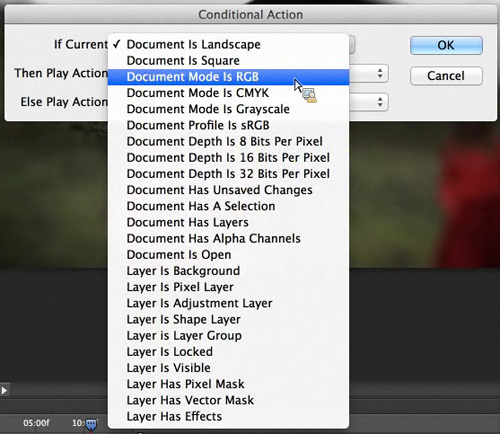
Conditions. The full list.
Zorana played an action that applied a watermark to an image in a different place depending on the image's orientation.
Photoshop is still used as a prototyping tool for Web design (despite all the other more options Adobe has bestowed on the design community). But it's always been a problem to translate things like typographic settings from the Photoshop document to a Web page's CSS file.
Well, no more. Photoshop now supports global paragraph and character styles and exports CSS style information. So right click on the layer, Copy CSS and paste it into any code preview application to see it applied to your HTML.
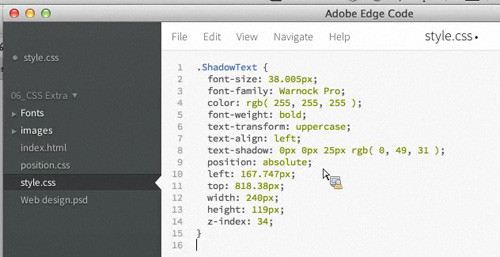
CSS Export. The ShadowText character style translated into CSS.
This release also has a few Just Do It improvements. You can load color swatches from a Web site CSS, HTML or SVG file. And you can move a path anchor point with the space bar. There are a few other JDIs she didn't cover, too.
Finally, there are 3D improvements in lighting options, which (being two dimensional people) we will spare you a description of.
DESKTOP SYNC
Senior Marketing Director Scott Morris explained Creative Cloud Connection, the desktop sync service that was already in what Adobe calls public preview. We had in fact installed it and kicked the tires. And liked it very much.
Like Dropbox, it creates a folder on your system that will upload anything you put in it to your Cloud storage. If you're working in a CS6 application, you can save to that hot folder and it will sync the document to the Cloud, too.
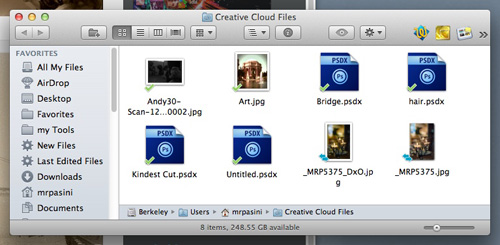
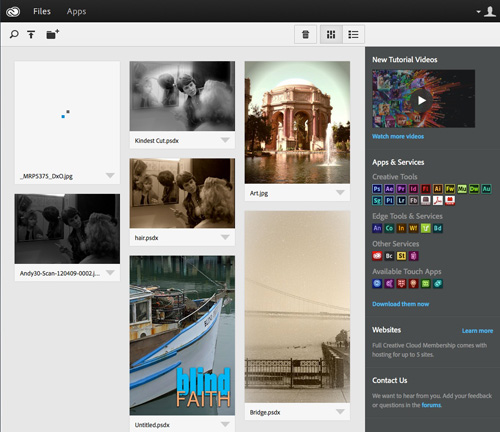
Two Views. Desktop view (top) shows two files to be synched and browser view shows one being uploaded.
You'll also be able to share a whole folder, not just a file, soon, Scott promised. And you can share these assets with a team, so you don't have to type in a bunch of email addresses.
TRAINING
Cloud members will also get online tutorials from "best of breed training partners" from the U.S., Japan and Europe, plus some Adobe content. Among the training partners are Kelby Training, video2brain and Attain.
"The goal here is to help customers be successful with all the stuff we're putting in Creative Cloud," Scott said. He was talking about cross training photographers to edit video and print designers to produce HTML. But we think it's essential basic orientation for all of these tools.
"We recognize this is a lot of stuff," he acknowledge. So the place you go to get your tools is also where you can get your training. "It's really just the beginning of what we're planning on doing with partners," he added. We'll see more of this partnering, he promised.
TEAMS
The existing Creative Cloud product is an individual product. But the company will now offer the volume licensing version of Creative Cloud for teams. The team gets all the individual tools and services but can also create virtual workgroups in your team, you get 100-GB storage (not 20-GB in the individual plan) and seat management tools, too.
There is also expert, not basic, support for each seat. Scott compared it to the Apple Genius bar, where you get individual attention with a phone and Web conference to work through the problem.
Now are you excited?
CONCLUSION
We were excited. We had already installed Creative Cloud Connection and found it immediately useful. And we had only a few days before confessed to our Adobe contact that we hadn't gotten very far with our evaluation of Muse because we kept stubbing our toe on things. We needed some, uh, training. Even though the tutorials were excellent, they only take you so far.
So outright prolonged applause for releasing all this usefulness so quickly to Creative Cloud subscribers. We said when we first wrote about Creative Cloud that it would be a whole new ballgame. And that's how it's working out. But rather than some ballpark surrounded by cornfields somewhere, it's more of a new universe where you can, overnight, pick up new powers to vanquish the dark forces surrounding cornfields everywhere. Level up!